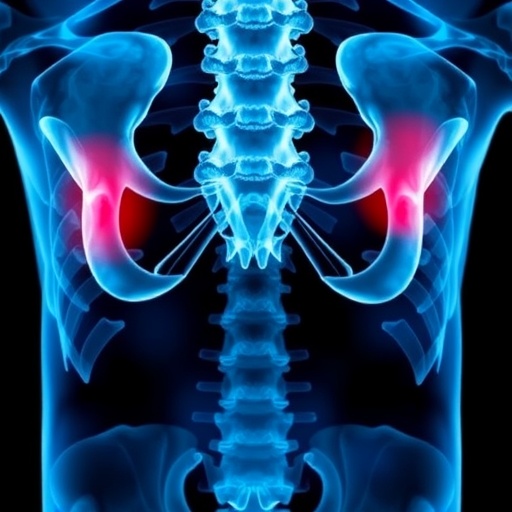The Integrin α2-Osteoclast Axis: A Potential Game Changer in Osteosarcoma Treatment
In an exciting development that could reshape the future of osteosarcoma treatment, researchers have uncovered a critical interaction between the integrin α2 and osteoclasts, presenting a potential therapeutic target. The team, led by Wei et al., recently published their findings in the Journal of Translational Medicine, detailing how the integrin α2-osteoclast axis serves as both a key driver of bone destruction and a promising target for innovative therapeutic strategies in osteosarcoma—one of the most common types of bone cancer found in children and adolescents.
Osteosarcoma is notorious for its aggressiveness and propensity for metastasis, particularly to the lungs. Traditional treatment modalities such as surgery, chemotherapy, and radiation often struggle to achieve the required efficacy, leading to high rates of recurrence and poor overall survival rates. This reality spurred a significant interest in understanding the underlying molecular mechanisms contributing to the disease’s progression, particularly those involving bone remodeling and cellular communication pathways.
The research team’s exploration of the integrin α2-osteoclast axis illuminated a vital connection between osteoclasts—bone-resorbing cells—and the integrin α2, a receptor that plays crucial roles in cell adhesion and signaling pathways. By dissecting the molecular interactions between these entities, the researchers demonstrated that osteoclasts interact extensively with the malignantly transformed cells of osteosarcoma, promoting an environment conducive to tumor growth and skeletal metastasis.
Integrins, including α2, serve as key players in mediating cell-to-cell interactions and are pivotal in transmitting biochemical signals from the extracellular matrix to the cell’s interior. The team discovered that osteosarcoma cells exploit the integrin α2 pathway to enhance their invasive properties and subsequently drive bone resorption mediated by osteoclasts. This relationship not only contributes to the destruction of bone tissue but also creates a feedback loop that further bolsters tumor proliferation and metastasis.
In their study, Wei et al. utilized a combination of in vitro and in vivo models to probe the functionality of the integrin α2-osteoclast interactions. They found that disrupting this axis resulted in a significant reduction in osteoclast activity and a consequent decrease in the invasive capability of osteosarcoma cells. These findings provide compelling evidence that targeting the integrin α2 pathway may offer a novel approach to inhibit osteosarcoma progression.
The researchers employed advanced techniques such as immunofluorescence microscopy and flow cytometry to quantify changes in osteoclast activity in the presence of osteosarcoma cells. Their data revealed a marked increase in bone resorption markers correlating with heightened integrin α2 expression levels. This relationship underscores the notion that manipulating integrin signaling could yield favorable outcomes in controlling both bone density and tumor burden within osteosarcoma patients.
Building upon these findings, the authors also propose the development of small-molecule inhibitors that specifically block integrin α2 function. Such pharmacological agents, they hypothesize, could interrupt the communication between osteosarcoma cells and osteoclasts, ultimately curtailing the pathological bone remodeling associated with the disease. Given the current limitations of chemotherapy and the toxicities often associated with traditional treatment methods, this approach has the potential to enhance quality of life while improving clinical outcomes.
Moreover, the implications of this research extend beyond osteosarcoma, as osteoclasts are implicated in various bone-related diseases, including osteoporosis and metastatic bone disease. The insights gained from the integrin α2-osteoclast axis could serve as a prototype for understanding other malignancies where the bone microenvironment plays a crucial role in tumor dynamics.
The investigators also discussed the potential for this therapeutic strategy to synergize with existing treatments. For instance, integrating an integrin α2-blocking agent with conventional chemotherapeutics could amplify anti-tumoral effects while mitigating the risk of bone metastasis. Such a combinatorial approach may significantly enhance response rates in patients who historically show limited remission due to drug-resistant tumor traits.
The research also emphasizes the necessity for clinical trials to validate the efficacy and safety of targeting the integrin α2-osteoclast axis in a clinical setting. Such studies would not only elucidate optimal dosing strategies but also help identify patient populations that may benefit the most from this novel intervention. Personalized medicine is a growing trend in oncology, and targeting this axis might pave the way for tailor-made therapeutic regimens for osteosarcoma patients.
As scientists continue to decode the complexities of osteosarcoma biology, the integrin α2-osteoclast interaction stands out as a focal point for future research. By continuing to illuminate the mechanisms of bone destruction in osteosarcoma, researchers aspire to unlock novel strategies that can diminish the mortality associated with this skeletal malignancy. This study not only opens new avenues for targeted therapy but also enhances our understanding of tumor-bone interactions that may redefine therapeutic landscapes across multiple cancers.
In summary, the research led by Wei et al. sheds light on the integrin α2-osteoclast axis as a critical driver of osteosarcoma progression. By targeting this axis, there lies a promising opportunity for advanced treatment strategies that could alter the disease’s trajectory. This breakthrough heralds a hopeful future for osteosarcoma patients and may inspire further investigations into similar pathways in other malignancies.
As the field moves forward, the implications of this discovery highlight the importance of interdisciplinary collaboration involving oncologists, molecular biologists, and pharmacologists to address the pressing challenges posed by osteosarcoma and to realize the potential of integrin signaling pathways in cancer treatment.
Subject of Research: Osteosarcoma treatment through the integrin α2-osteoclast axis.
Article Title: The integrin α2-osteoclast axis: a key driver of bone destruction and therapeutic target in osteosarcoma.
Article References: Wei, H., Shi, K., Huang, D. et al. The integrin α2-osteoclast axis: a key driver of bone destruction and therapeutic target in osteosarcoma. J Transl Med 23, 1204 (2025). https://doi.org/10.1186/s12967-025-06906-4
Image Credits: AI Generated
DOI:
Keywords: Integrin α2, osteoclasts, osteosarcoma, bone destruction, therapeutic targets.




